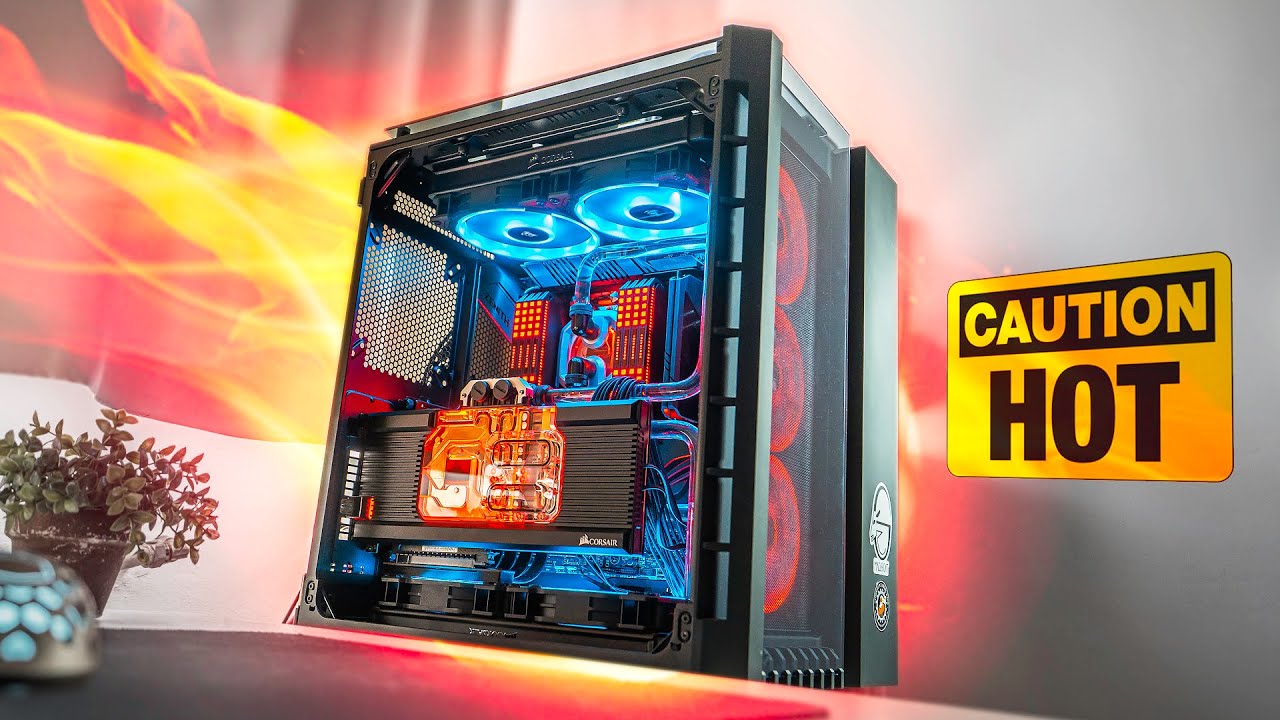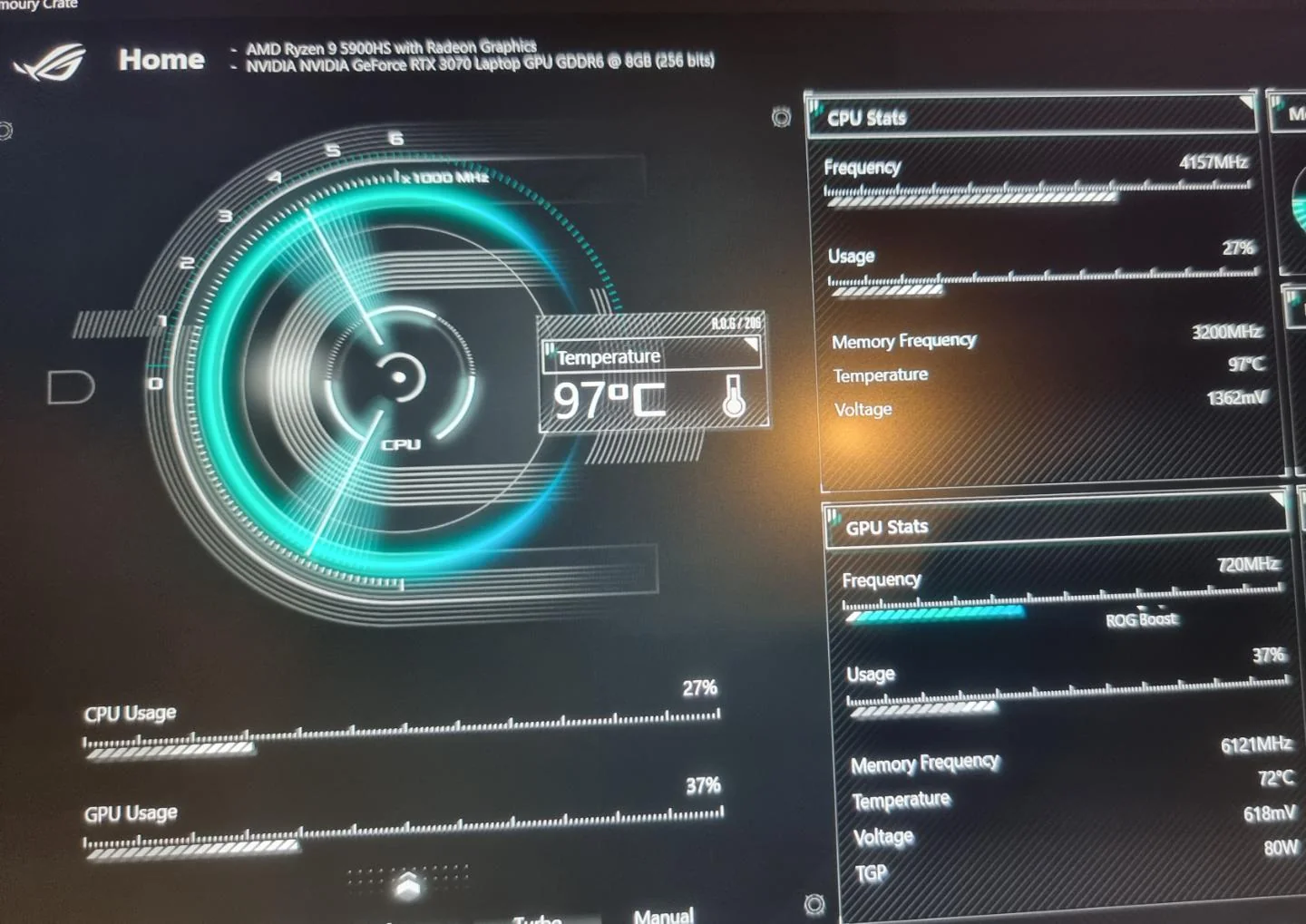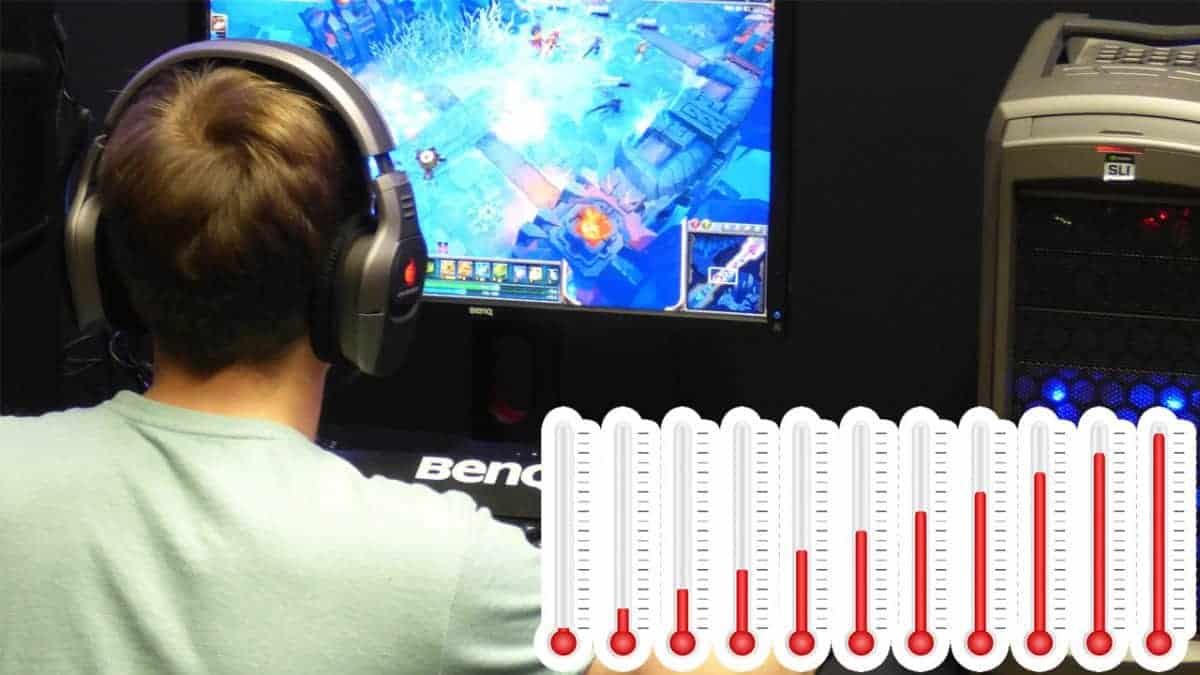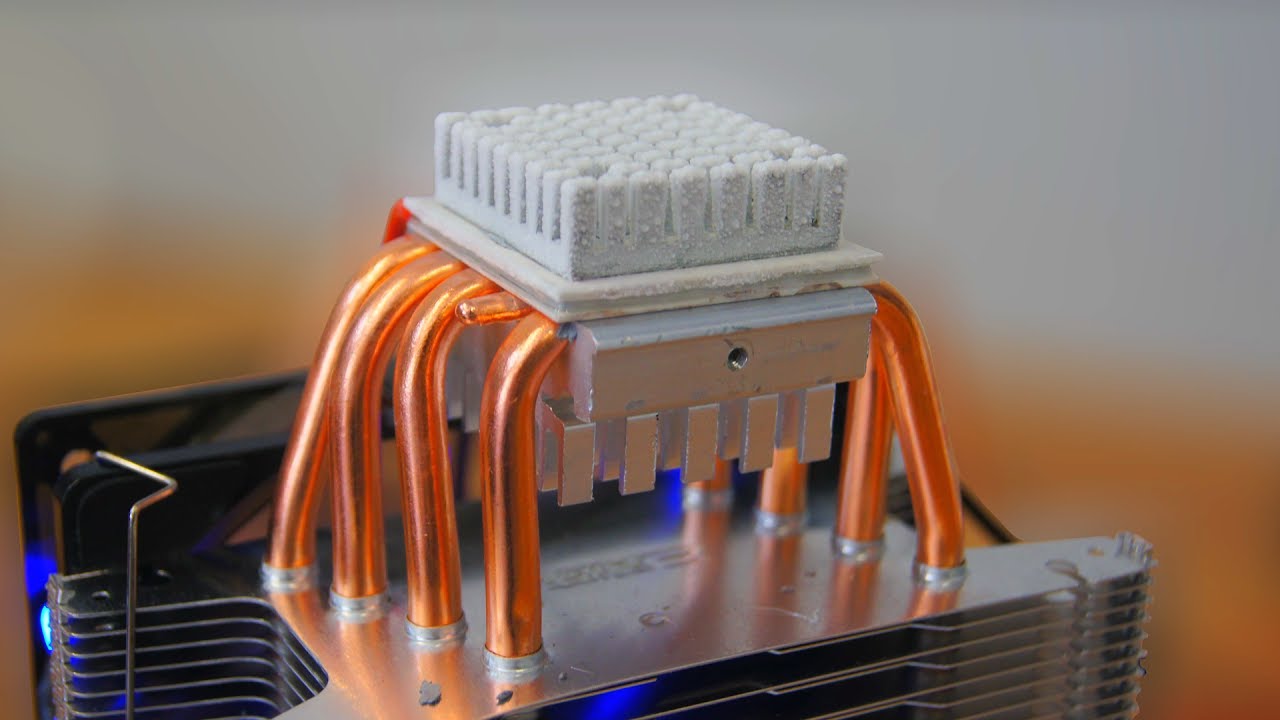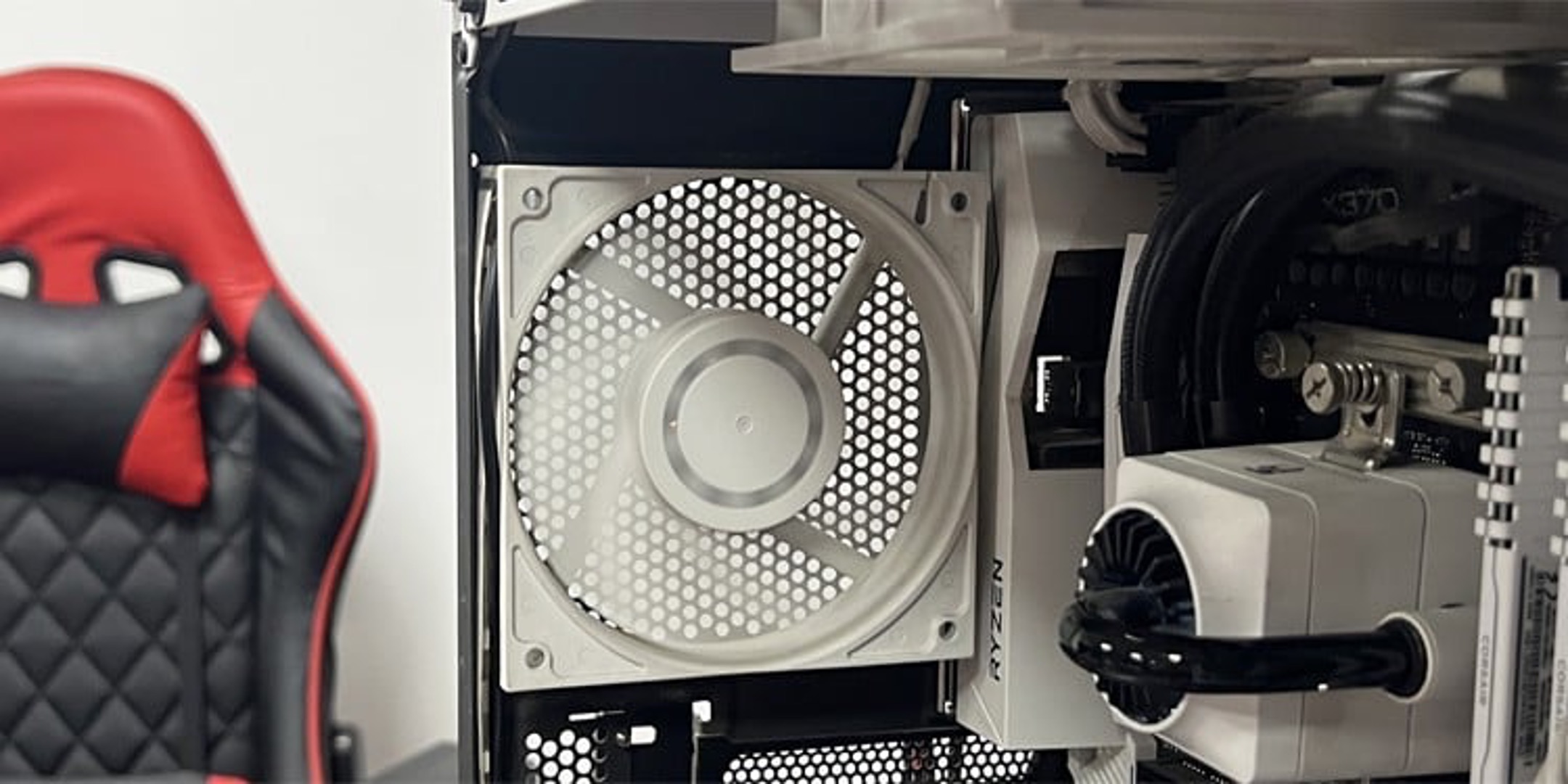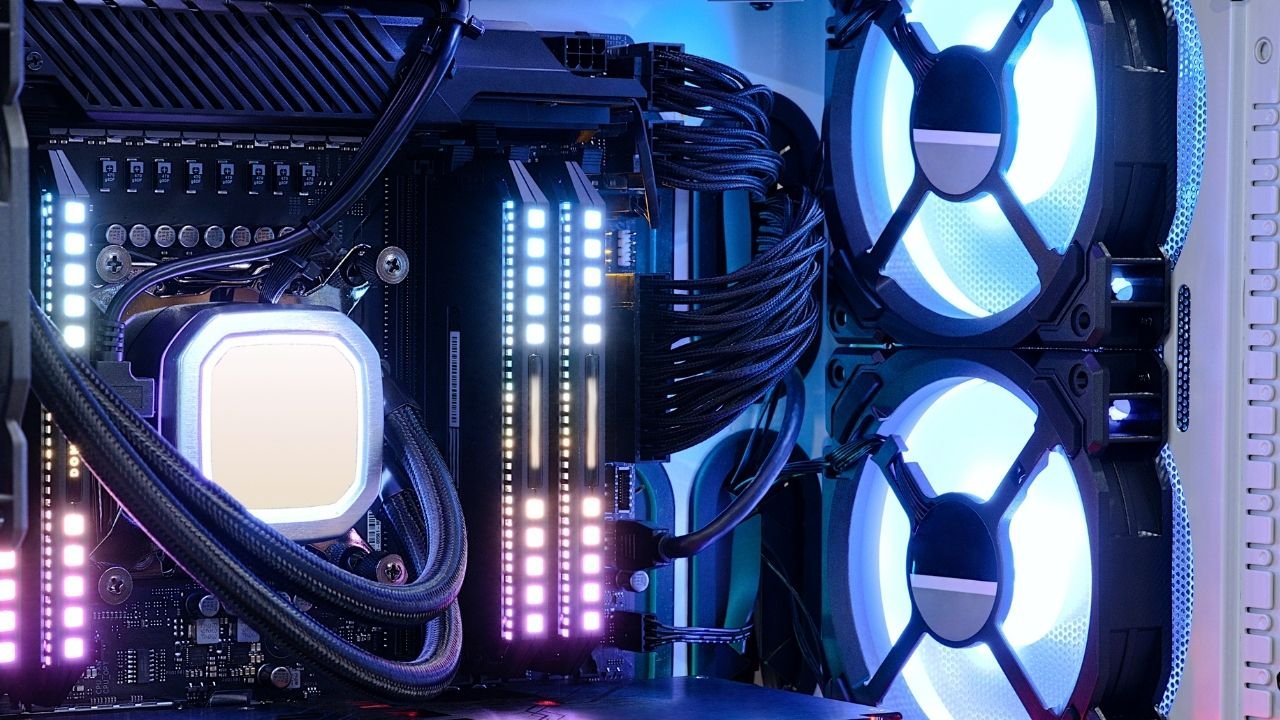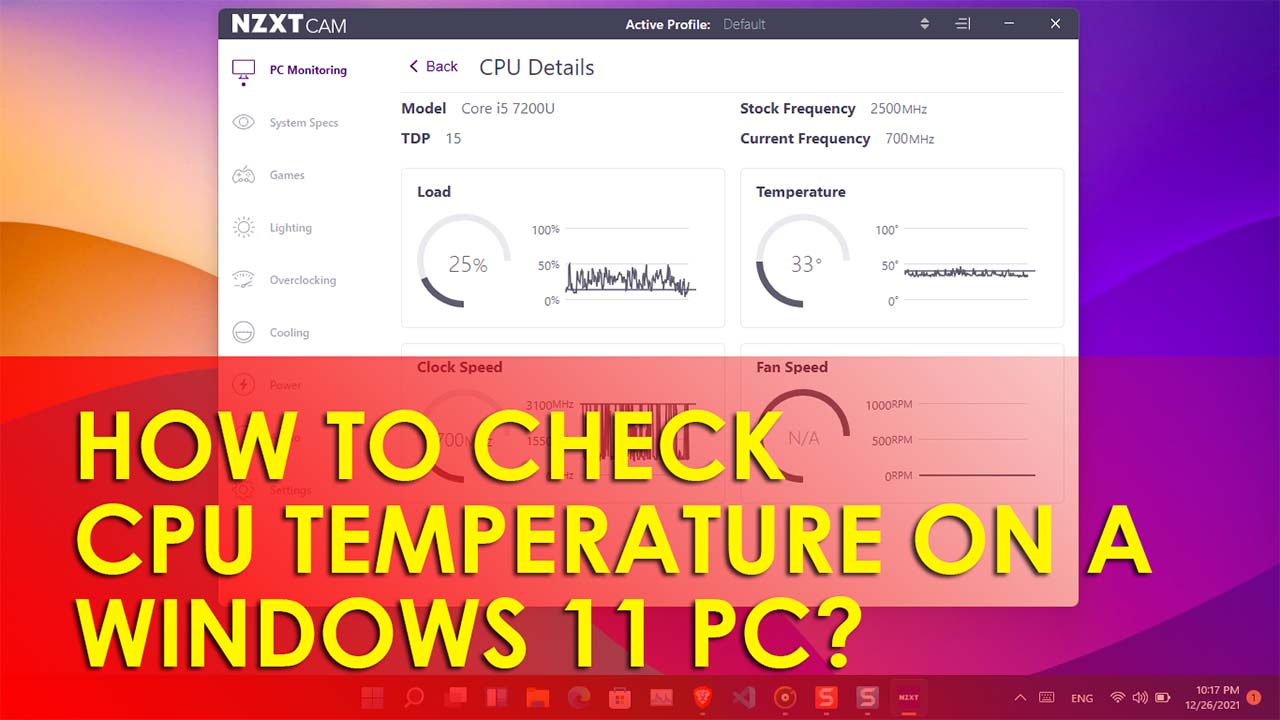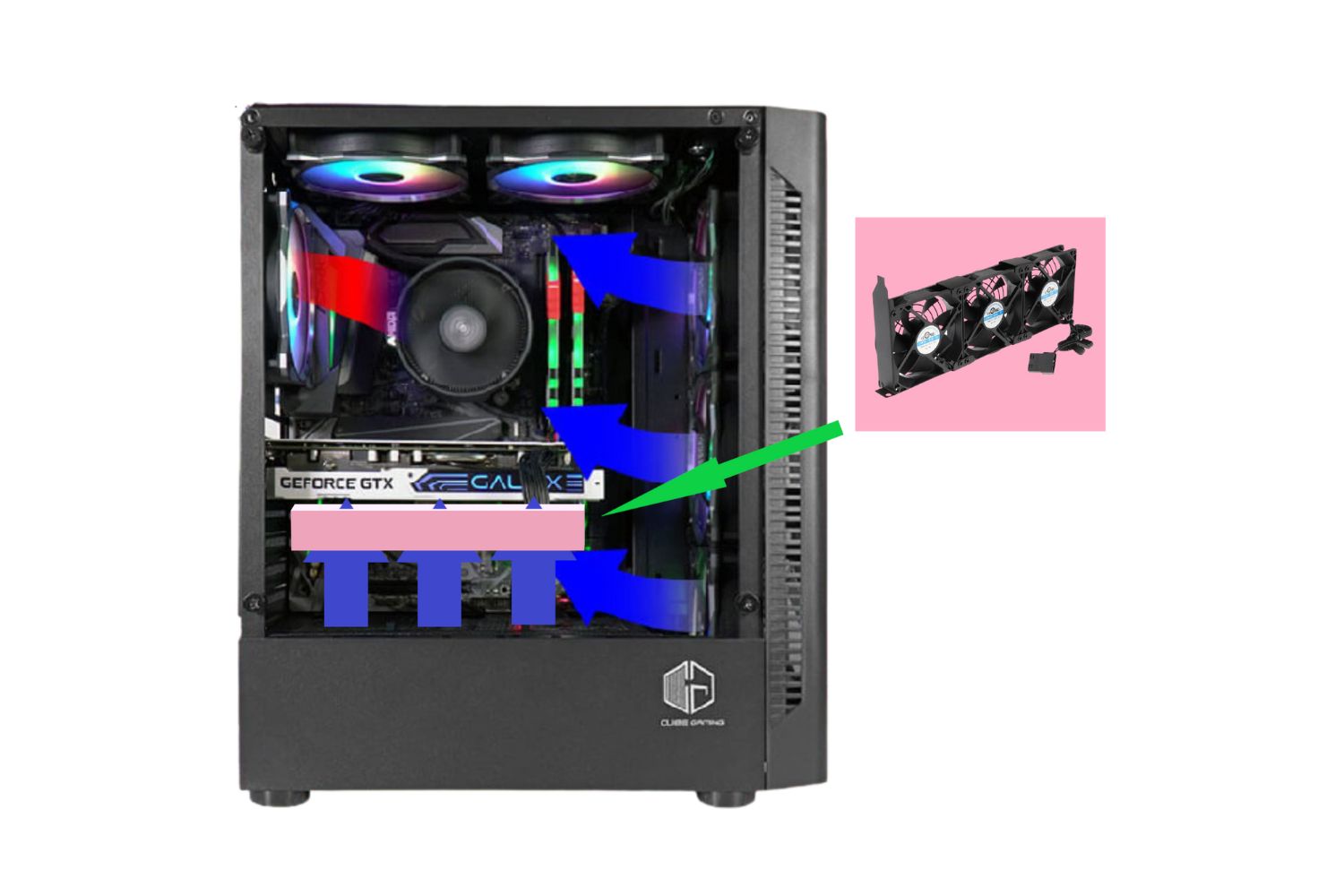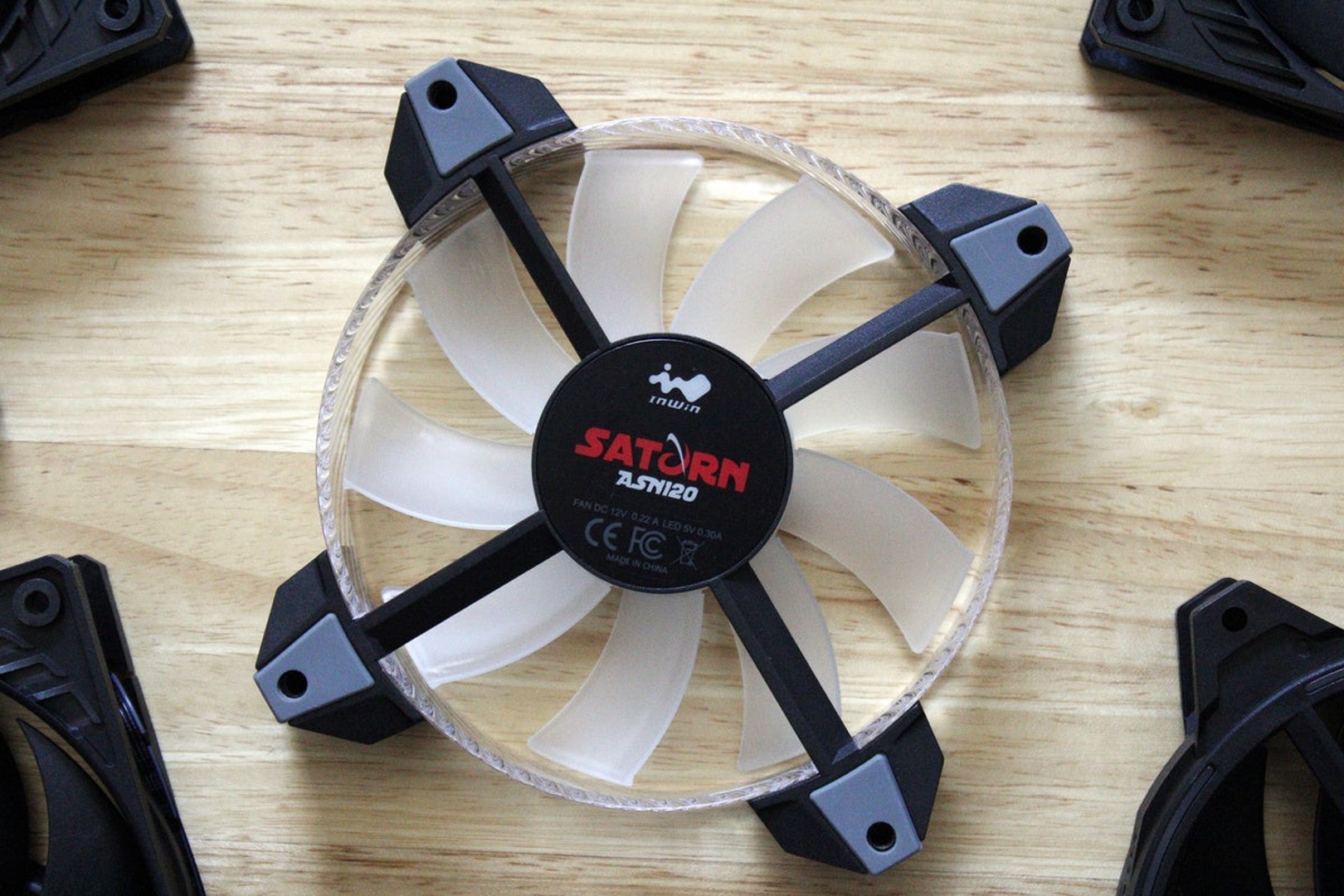Introduction
Having a computer that runs smoothly and efficiently relies on keeping its hardware within optimal temperature ranges. One crucial component that can overheat is the Central Processing Unit (CPU). When a CPU gets too hot, it can lead to decreased performance, system crashes, and even permanent damage. Therefore, understanding why your CPU is getting hot and knowing how to prevent it is essential for maintaining the longevity and performance of your computer.
CPU temperature refers to the measurement of the heat generated by the central processing unit of your computer. CPUs generate heat during operation, and for optimal performance, it is important to keep the temperature in check. The recommended temperature range varies depending on the specific CPU model, but in general, keeping the temperature below 70 degrees Celsius (158 degrees Fahrenheit) is ideal.
There are various factors that can contribute to high CPU temperatures. Insufficient cooling is one of the most common causes. If your computer’s cooling system, such as fans or heat sinks, is not adequate for the workload or the ambient temperature, the CPU will struggle to dissipate heat effectively. Additionally, dust and dirt build-up can obstruct airflow and lead to heat accumulation. Overclocking, a process of pushing the CPU beyond its recommended specifications, can also significantly increase its temperature.
Inadequate application of thermal paste, a substance that aids in heat transfer between the CPU and the cooler, can create air gaps and hinder heat dissipation. Aging hardware, including worn-out fans or degraded thermal conductivity of the CPU itself, can contribute to higher temperatures. Running intensive programs, such as video editing or gaming applications, can put a heavy load on the CPU and lead to increased heat generation.
By understanding the causes of high CPU temperature, you can effectively take preventive measures to avoid overheating and maintain the optimal performance of your computer. In the following sections, we will explore the common signs of overheating, how to monitor CPU temperature, and practical ways to keep your CPU cool.
What is CPU Temperature?
CPU temperature refers to the measurement of the heat generated by the Central Processing Unit (CPU) of a computer. The CPU is often considered the “brain” of the computer, as it performs the majority of the calculations and processes necessary for the system to function. However, this computational power comes at a cost: heat generation.
As the CPU carries out various instructions and operations, it consumes electrical power. This electrical power is converted into usable energy, but a portion of it is also transformed into heat. If this heat is not effectively dissipated, the temperature of the CPU can rise to dangerous levels, leading to performance degradation, system instability, and potentially irreversible damage.
Understanding the temperature at which the CPU operates is crucial for maintaining a healthy computer system. Most CPUs have temperature sensors embedded within their architecture, which allow users to monitor and regulate the temperature. The temperature is usually reported in degrees Celsius (°C) or Fahrenheit (°F).
Each CPU has a recommended temperature range provided by the manufacturer. Operating within this specified range helps ensure that the CPU is functioning optimally and that it remains within safe operating temperatures. For example, a commonly recommended temperature range for CPUs is below 70°C (158°F).
Overheating can occur when the CPU temperature exceeds the safe operating range. Continuous operation at high temperatures can reduce the lifespan of the CPU and increase the likelihood of system crashes or component failures. Therefore, it is essential to monitor the CPU temperature regularly and take appropriate steps to prevent overheating.
CPU temperature can be influenced by various factors, including the workload, ambient temperature, cooling system efficiency, and the specific CPU model. It is worth noting that certain tasks, such as video rendering, gaming, or running resource-intensive applications, can generate more heat and increase the CPU temperature significantly.
In the following sections, we will explore the causes of high CPU temperature, signs of overheating, monitoring techniques, and effective strategies to keep your CPU cool. By maintaining a healthy CPU temperature, you can maximize the performance and longevity of your computer system.
Causes of High CPU Temperature
There are several factors that can contribute to high CPU temperatures. Understanding these causes can help you pinpoint the issue and take necessary steps to prevent overheating. Here are some common reasons why your CPU temperature may be higher than normal:
1. Insufficient Cooling: Inadequate cooling is a common cause of high CPU temperatures. If your computer’s cooling system, such as fans or heat sinks, is not powerful enough to handle the heat generated by the CPU, it can lead to temperature spikes.
2. Dust and Dirt Build-Up: Over time, dust and dirt can accumulate inside your computer, clogging up the cooling system. This build-up restricts airflow and hampers the cooling efficiency, resulting in higher CPU temperatures.
3. Overclocking: Overclocking refers to pushing the CPU beyond its recommended clock speed. While it can provide a performance boost, it also generates more heat. As a result, the CPU may struggle to dissipate heat effectively, leading to increased temperatures.
4. Inadequate Thermal Paste Application: Thermal paste is a substance that facilitates heat transfer between the CPU and the cooler. Improper application, such as too little or uneven spread, can create air gaps or impede thermal conductivity, causing higher CPU temperatures.
5. Aging Hardware: As computer components age, their cooling capabilities may degrade. Worn-out cooling fans or reduced thermal conductivity of the CPU itself can result in increased temperatures.
6. Running Intensive Programs: Certain tasks, such as video editing, 3D rendering, or gaming, can put a significant load on the CPU, causing it to work harder and generate more heat. If the cooling system is not adequate to handle these demanding tasks, the CPU temperature can rise.
Identifying the cause of high CPU temperatures is crucial for implementing effective solutions. In the following sections, we will explore common signs of overheating, methods to monitor CPU temperature, and practical ways to keep your CPU cool. By addressing these causes, you can ensure optimal performance and extend the lifespan of your computer.
Insufficient Cooling
One of the primary reasons for high CPU temperatures is insufficient cooling. When your computer’s cooling system is not capable of effectively dissipating the heat generated by the CPU, it can lead to temperature spikes and potential overheating. Here are some factors that can contribute to insufficient cooling:
1. Inadequate Fan Configuration: Having an insufficient number of fans, or incorrectly positioned fans, can impede airflow within the computer case. This can lead to heat buildup around the CPU, resulting in higher temperatures. Ensuring that your computer has an adequate number of fans, strategically placed to promote efficient airflow, is crucial for maintaining optimal CPU temperatures.
2. Fan Malfunction: Over time, cooling fans can wear out or become clogged with dust, reducing their effectiveness. A malfunctioning fan may not spin at the required speed, resulting in poor heat dissipation. Regularly checking and cleaning your fans, and replacing them if necessary, can help prevent insufficient cooling.
3. Incompatible Cooling System: Different CPUs require different cooling solutions. Using a cooling system that is not specifically designed for your CPU may result in ineffective heat dissipation. Ensure that you have a compatible cooling system that can handle the heat generated by your CPU.
4. High Ambient Temperature: The ambient temperature in the room where your computer is located plays a significant role in CPU temperature. If the room temperature is already high, it becomes harder for the cooling system to lower the CPU temperature. Consider keeping your computer in a well-ventilated space or using air conditioning to help maintain a cooler environment.
5. Overpopulated Computer Case: Having too many components crammed into a small computer case can restrict airflow, hindering the cooling system’s efficiency. Ensuring that there is enough space within the case for proper airflow is essential for preventing overheating.
Addressing insufficient cooling is crucial for maintaining optimal CPU temperatures. Consider upgrading your cooling system, ensuring proper fan configuration, cleaning and maintaining your fans regularly, and providing adequate space for airflow. By addressing these issues, you can effectively prevent overheating and ensure that your CPU operates within safe temperature ranges.
Dust and Dirt Build-Up
Dust and dirt accumulation within your computer can significantly contribute to high CPU temperatures. Over time, these particles can settle on cooling components such as fans, heat sinks, and vents, obstructing airflow and impeding the cooling system’s efficiency. Here are some factors to consider regarding dust and dirt build-up:
1. Airflow Restriction: Dust and dirt can clog the small spaces between cooling fins and obstruct the movement of air. This restricts proper airflow around the CPU, leading to heat buildup and higher temperatures. Regular cleaning of these components can help prevent airflow restriction and maintain optimal cooling.
2. Fan Performance Impairment: Dust can coat fan blades, causing them to become unbalanced or reduce their spinning speed. This impairment can result in inefficient heat dissipation and inadequate cooling. Regularly cleaning your fans can repair their performance and prevent further temperature issues.
3. Thermal Insulation: Thick layers of dust can act as an insulator, trapping heat inside the computer case. This creates an environment where the CPU temperature increases significantly. Cleaning the internal components, including the heat sink and CPU, can eliminate this insulating effect and restore proper heat dissipation.
4. System Instability: High temperatures resulting from dust and dirt build-up can cause system instability and even crashes. It is important to regularly clean your computer to prevent overheating-related issues that can impact the overall performance and reliability of your system.
Preventing dust and dirt build-up is essential for maintaining a well-functioning cooling system and optimal CPU temperatures. Here are some tips to help you mitigate this problem:
– Regular Cleaning: Regularly clean your computer using compressed air, a soft brush, or vacuum cleaner attachments, taking care not to damage any components. Pay close attention to the fans, heat sinks, and vents to remove accumulated dust and dirt.
– Dust Filters: Consider installing dust filters on the intake fans or vents of your computer case. These filters can help prevent larger particles from entering the system, reducing the amount of dust and dirt that accumulates.
– Proper Environment: Keep your computer in a clean and dust-free environment. Avoid placing it on the floor or near areas prone to dust accumulation, such as carpets or open windows.
By regularly cleaning your computer and reducing the amount of dust and dirt build-up, you can ensure better airflow and heat dissipation, thus preventing high CPU temperatures and maintaining stable system performance.
Overclocking
Overclocking is the process of pushing a CPU or other computer components beyond their default factory settings to achieve higher performance. While overclocking can provide a significant boost in processing power, it also generates more heat. Here are some key points to consider regarding the impact of overclocking on CPU temperatures:
1. Increased Voltage and Power Consumption: Overclocking often requires an increase in CPU voltage and power consumption to sustain the higher clock speeds. This results in a higher heat output, which can lead to elevated CPU temperatures.
2. Inadequate Cooling: Because overclocking increases the CPU’s performance capabilities, the cooling system must also be enhanced to handle the additional heat generated. Insufficient cooling during overclocking can cause the CPU temperature to rise rapidly and result in overheating.
3. Reduced CPU Lifespan: Overclocking creates additional stress on the CPU, forcing it to operate beyond its designed specifications. This can shorten the lifespan of the CPU and lead to premature failure if not properly managed, especially if high temperatures are sustained over a long period of time.
When overclocking, it is crucial to monitor CPU temperatures closely to prevent overheating. Here are some tips to help you mitigate the temperature impact of overclocking:
– Enhanced Cooling System: Invest in a robust cooling system, including high-performance CPU coolers, case fans, and adequate airflow to effectively dissipate increased heat resulting from overclocking.
– Thorough Stability Testing: After overclocking, perform stability tests to ensure that the CPU is running at a safe temperature under a heavy workload. This will help identify any cooling deficiencies or potential issues before prolonged use.
– Properly Apply Thermal Paste: Use a high-quality thermal paste and ensure it is applied evenly between the CPU and the cooler. This will maximize thermal conductivity and assist in efficient heat transfer.
– Monitor CPU Temperature: Utilize software utilities or BIOS options to monitor the CPU temperature in real-time. Set up temperature alerts or automatic shutdowns to safeguard against excessive heat levels.
Overclocking can provide a significant boost in performance, but it must be done with caution to prevent high CPU temperatures that can lead to instability and damage. Proper cooling, stability testing, and monitoring are essential when engaging in overclocking activities to ensure a safe and controlled environment for the CPU to operate optimally.
Inadequate Thermal Paste Application
The application of thermal paste is crucial for maintaining optimal CPU temperatures. Thermal paste, also known as thermal compound or thermal grease, is a material that improves thermal conductivity between the CPU and the cooler. Improper application or inadequate use of thermal paste can hinder heat transfer and contribute to higher CPU temperatures. Here are some key points to consider regarding thermal paste:
1. Air Gaps and Uneven Spreading: When thermal paste is not applied properly, air gaps or uneven spreading can occur between the CPU and the cooler. These gaps act as thermal insulators, resulting in reduced heat dissipation and increased CPU temperatures.
2. Excessive or Insufficient Amount: Using too much or too little thermal paste can both lead to temperature issues. Excessive paste can create unnecessary thickness, impeding heat transfer, while insufficient paste may not fill the microscopic imperfections between the CPU and the cooler surface effectively.
3. Low-Quality Thermal Paste: Not all thermal pastes are made equal. Low-quality or expired thermal paste may have reduced thermal conductivity, hindering its effectiveness in transferring heat. Choosing a reputable brand and ensuring the thermal paste is fresh can significantly impact its performance.
4. Dry or Deteriorated Thermal Paste: Over time, thermal paste can dry out or deteriorate, losing its thermal conductivity properties. This can result in increased CPU temperatures. It is advisable to periodically replace the thermal paste, especially if you notice a significant increase in temperatures.
To ensure proper thermal paste application and maintain optimal CPU temperatures, follow these guidelines:
– Clean the CPU and Cooler: Before applying thermal paste, ensure that both the CPU and cooler surfaces are clean and free of dust or previous thermal paste residue. Use isopropyl alcohol and a lint-free cloth or cotton swab to clean them effectively.
– Apply the Right Amount: Use an appropriate amount of thermal paste, usually a small pea-sized dot, at the center of the CPU. Avoid using excessive amounts that can overflow or insufficient amounts that may not cover the entire surface.
– Spread Evenly: Once the thermal paste is applied, gently place the cooler onto the CPU and apply mild pressure to spread the paste evenly. This ensures proper contact and helps eliminate air gaps.
– Choose Quality Thermal Paste: Invest in high-quality thermal paste from reputable manufacturers. Research and reviews can guide you in selecting a suitable product for your specific needs.
Proper thermal paste application is essential for maintaining efficient heat transfer between the CPU and cooler. By following these guidelines, you can ensure optimal performance and lower CPU temperatures, reducing the risk of overheating and potential damage to your system.
Aging Hardware
Aging hardware can be a contributing factor to high CPU temperatures. Over time, the performance and efficiency of cooling components can degrade, leading to inadequate heat dissipation and increased temperatures. Here are some key points to consider regarding aging hardware:
1. Worn-out Cooling Fans: Cooling fans inside your computer can wear out over time, resulting in decreased airflow and reduced cooling efficiency. If the fans do not spin at the required speed or fail altogether, the CPU may not receive proper cooling, leading to higher temperatures.
2. Dust Accumulation: As hardware ages, dust and dirt can accumulate more easily in the nooks and crannies of the cooling system. This accumulation can obstruct airflow, preventing efficient heat dissipation and causing the CPU temperature to rise.
3. Degraded Thermal Conductivity: The thermal conductivity of materials, such as the CPU itself or the thermal paste, can deteriorate over time. Reduced thermal conductivity hampers the transfer of heat from the CPU to the cooler, resulting in higher CPU temperatures.
4. Outdated Technology: Older CPUs may generate more heat compared to their modern counterparts. Older computer models may also have outdated cooling systems that are not efficient at managing the increased heat output of modern CPUs.
To mitigate the impact of aging hardware on CPU temperatures, consider the following actions:
– Replace Worn-out Fans: Regularly check the condition of your cooling fans and replace any that are worn out or no longer performing optimally. Upgrading to higher-quality fans can also improve cooling performance.
– Clean Dust and Dirt: Frequently clean your computer internals, especially cooling components, to remove dust and dirt buildup. This helps maintain proper airflow and prevents overheating caused by inadequate heat dissipation.
– Upgrade Thermal Paste: Replace the thermal paste between the CPU and the cooler if it has dried out or lost its effectiveness. Fresh thermal paste promotes better heat transfer and can help reduce CPU temperatures.
– Consider Hardware Upgrades: If your computer is significantly outdated, consider upgrading to a newer model with more efficient cooling systems. This can ensure better heat management and lower CPU temperatures.
By addressing the challenges posed by aging hardware, you can optimize cooling performance and maintain healthy CPU temperatures. Regular maintenance, upgrades when necessary, and proper heat management are key to mitigating the negative effects of aging hardware on CPU temperatures.
Running Intensive Programs
Running intensive programs, such as video editing software, 3D rendering applications, or resource-heavy games, can significantly impact CPU temperatures. These programs put a heavy workload on the CPU, causing it to work harder and generate more heat. Here are some key points to consider regarding the impact of running intensive programs on CPU temperatures:
1. Increased CPU Usage: Intensive programs require extensive CPU usage, pushing it to its limits. As a result, the CPU generates more heat during its operation, leading to higher CPU temperatures.
2. Prolonged High CPU Loads: Running resource-intensive programs for an extended period of time can subject the CPU to sustained high loads and heat generation. This can cause the CPU temperature to rise, potentially leading to overheating if proper cooling measures are not in place.
3. Inadequate Cooling Solution: If the cooling system in your computer is not designed to handle the heat generated by running intensive programs, the CPU may struggle to dissipate heat efficiently. This can result in higher temperatures and potential thermal throttling.
To mitigate the impact of running intensive programs on CPU temperatures, consider the following actions:
– Optimized Cooling System: Ensure that your computer’s cooling system is capable of handling the heat generated during intensive tasks. Consider upgrading fans, heat sinks, or even liquid cooling solutions to provide better heat dissipation.
– Proper Airflow: Maintain proper airflow within your computer case by organizing cables, removing obstructions, and managing clutter. Good airflow helps remove hot air from around the CPU, reducing overall temperatures.
– Cooling Pad for Laptops: If you are running intensive programs on a laptop, consider using a laptop cooling pad to improve airflow and prevent overheating.
– Take Breaks: To prevent prolonged high CPU loads and excessive heat buildup, take breaks between intensive tasks. This allows the CPU to cool down and reduces the risk of overheating.
– Monitor CPU Temperatures: Utilize software tools or hardware monitoring devices to keep an eye on your CPU temperatures while running intensive programs. This will help you identify potential issues and take preventive measures if temperatures become too high.
By implementing these measures, you can better manage CPU temperatures while running intensive programs. This ensures optimal performance and reduces the risk of system instability or damage caused by overheating.
Common Signs of Overheating
Identifying the signs of overheating is crucial for preventing damage to your computer’s components. Here are some common indicators that your CPU may be running too hot:
1. System Slowing Down: As the CPU temperature rises, the computer may start to slow down. This can be observed when opening programs, navigating through windows, or experiencing delays in response times.
2. Frequent System Crashes: Overheating can cause the system to become unstable, resulting in sudden crashes, freezes, or spontaneous reboots. If you notice that your computer is crashing more frequently, overheating may be the culprit.
3. Loud Fan Noise: When the CPU temperature rises, the cooling fans inside your computer will work harder to dissipate the heat. This can lead to an increase in fan speed and produce noticeable and unusually loud noise.
4. Excessive Heat from the Case: If you touch the computer case and it feels unusually hot to the touch, it can indicate that the internal components, including the CPU, are overheating. Exercise caution when touching the case, as it may be uncomfortable or even burn your skin if temperatures are extremely high.
5. Blue Screen of Death (BSOD): Overheating can trigger system instability, leading to the infamous Blue Screen of Death error. If you encounter frequent BSOD errors, overheating could be a potential cause.
6. Automatic Shutdowns: To prevent damage from overheating, your computer may automatically shut down to protect itself. If you experience sudden and unexpected shutdowns, it may be a sign that your CPU is overheating and triggering the shutdown mechanism.
If you notice any of these signs, it is important to take immediate action to prevent further damage. Here are some steps you can take:
– Check Cooling System: Make sure that the cooling fans are working properly and that the airflow within the computer case is not obstructed by dust or other debris.
– Clean the Computer: Regularly clean the internal components, including cooling fans and heat sinks, to remove dust and dirt buildup that can impede airflow.
– Improve Ventilation: Ensure that your computer is placed in a well-ventilated area, away from heat sources or confined spaces, to promote better airflow and heat dissipation.
– Reduce Workload and Monitor CPU Usage: Limit the number of running programs or tasks that put a heavy load on the CPU. Use software utilities or task managers to monitor CPU usage and identify any processes that may be causing excessive heat generation.
– Consider Hardware Upgrades: If your computer’s components are aging, consider upgrading to newer and more efficient cooling solutions or even a newer model with better thermal management capabilities.
By recognizing the signs of overheating and taking appropriate measures, you can prevent further damage and ensure the longevity and performance of your computer system.
Monitoring CPU Temperature
Monitoring the temperature of your CPU is essential for ensuring that it operates within safe limits and to identify potential overheating issues before they cause damage. By regularly monitoring CPU temperature, you can take preventive measures to address any temperature-related issues. Here are some key points to consider when monitoring CPU temperature:
1. Software Monitoring Tools: Various software applications are available that allow you to monitor CPU temperature in real-time. These tools provide detailed information about the current temperature, as well as temperature trends over time.
2. BIOS Temperature Readings: Most computer motherboards offer BIOS options that allow you to monitor CPU temperature. You can access this information during the computer’s startup by entering the BIOS settings.
3. Temperature Sensors: Modern CPUs have built-in sensors that provide accurate temperature readings. These sensors are designed to measure the CPU temperature and report it to the monitoring software or BIOS.
4. Temperature Alerts: Some monitoring tools allow you to set temperature thresholds and receive alerts if the CPU temperature exceeds a specified limit. This alert system helps you take immediate action if the temperature becomes dangerously high.
5. Historical Data Analysis: Monitoring tools often provide the capability to review historical temperature data. By analyzing temperature trends, you can identify patterns that may indicate potential overheating issues or the need for cooling system adjustments.
When monitoring CPU temperature, keep the following tips in mind:
– Monitor During Intensive Tasks: Check CPU temperature when running resource-intensive programs, such as games or rendering software, to ensure the CPU temperature remains within safe limits.
– Regularly Review Temperatures: Make it a habit to check CPU temperatures regularly, especially if you use your computer for extended periods or perform demanding tasks that put a heavy load on the CPU.
– Consider Multiple Monitoring Tools: Using multiple monitoring tools can provide cross-validation of temperature readings, giving you a more accurate understanding of your CPU’s temperature.
– Watch for Sudden Temperature Spikes: If you notice sudden and significant temperature spikes, it could indicate a cooling system issue or an improperly applied thermal paste. Investigate and address the source of the spike to prevent overheating.
By actively monitoring CPU temperature, you can stay informed about the health and performance of your CPU. Regular temperature checks and awareness of any potential issues allow you to take proactive steps to prevent overheating and ensure the longevity and reliability of your computer system.
How to Keep Your CPU Cool
Maintaining an optimal temperature for your CPU is crucial for its performance and longevity. To keep your CPU cool, consider implementing the following strategies:
1. Install Sufficient Cooling: Make sure your computer has an adequate cooling system in place. This can include CPU coolers, case fans, liquid cooling solutions, or a combination of these. Choose cooling components that match the cooling requirements of your CPU and provide efficient heat dissipation.
2. Clean Dust and Dirt Regularly: Dust and dirt can accumulate on cooling components, obstructing airflow and reducing cooling efficiency. Regularly clean your computer internals, including fans, heat sinks, and vents, to remove dust and maintain optimum airflow.
3. Avoid Overclocking or Optimize Settings: Overclocking puts additional stress on the CPU and generates more heat. If you are concerned about heat generation, avoid overclocking or optimize the settings to find the right balance between performance and temperature.
4. Apply Thermal Paste Properly: Ensure that you apply an adequate amount of high-quality thermal paste between the CPU and the cooler. This promotes efficient heat transfer and helps fill in any gaps or imperfections for better thermal conductivity.
5. Upgrade Aging Hardware: If your cooling system or CPU is significantly outdated, consider upgrading to more efficient and modern components. Newer hardware often provides better heat management and cooling capabilities.
6. Close Unnecessary Programs: Running multiple programs simultaneously can put a heavy load on the CPU and generate excess heat. Close any unnecessary programs or background processes to minimize CPU usage, reduce heat generation, and maintain lower temperatures.
7. Monitor CPU Temperature: Use software monitoring tools or BIOS options to keep an eye on CPU temperature in real-time. Monitoring allows you to detect any temperature abnormalities and take appropriate action.
8. Ensure Proper Ventilation: Ensure that your computer case has proper ventilation and adequate airflow. Keep the vents clear of obstructions and avoid placing the computer in enclosed spaces. Good ventilation helps dissipate heat more effectively.
9. Manage Cable Placement: Proper cable management inside your computer case improves airflow and prevents cables from obstructing the cooling system. Neatly organize cables and use appropriate cable management solutions to maintain a clean and efficient airflow path.
10. Control Room Temperature: Keep your computer in an environment with a moderate temperature. High ambient temperatures can make it harder for the cooling system to keep the CPU cool. Avoid placing the computer near heat sources or direct sunlight.
By implementing these strategies, you can effectively keep your CPU cool and maintain optimal performance. Regular maintenance, proper cooling system configuration, and temperature monitoring are essential to ensure that your CPU operates within safe temperature limits for extended periods of time.
Install Sufficient Cooling
Installing sufficient cooling for your computer is essential for keeping your CPU cool and maintaining its optimal performance. Inadequate cooling can lead to increased CPU temperatures, which can result in decreased performance, system instability, and potential hardware damage. Here are some key points to consider when it comes to installing sufficient cooling:
1. CPU Coolers: A CPU cooler is an essential component for dissipating the heat generated by the CPU. There are various types of CPU coolers available, including air coolers and liquid coolers. Choose a cooler that matches your CPU’s cooling requirements and fits within your computer case.
2. Case Fans: Case fans play a crucial role in cooling the overall system, including the CPU. They facilitate airflow by drawing cool air into the case and expelling hot air. Position case fans strategically to ensure proper airflow across the CPU and other components.
3. Heat Sinks: Heat sinks are metal components that help absorb and dissipate heat from the CPU. They are often paired with a CPU cooler to enhance cooling efficiency. Ensure that your CPU cooler is compatible with the heat sink to maximize the heat dissipation process.
4. Liquid Cooling Solutions: Liquid cooling systems, also known as all-in-one (AIO) coolers or custom loop cooling solutions, offer excellent heat dissipation capabilities. These systems utilize liquid coolant to efficiently transfer heat from the CPU to a radiator, where it is then dissipated by fans. Liquid cooling solutions are especially effective for overclocked CPUs or systems with high thermal demands.
5. Thermal Conductivity: When installing cooling components, it is important to pay attention to thermal conductivity. Ensure that proper thermal paste is applied between the CPU and the cooler. This paste helps minimize the thermal resistance between the CPU and the cooler, improving heat transfer efficiency.
To install sufficient cooling, follow these guidelines:
– Research and Choose Quality Cooling Components: Conduct thorough research to identify high-quality CPU coolers, case fans, and other cooling components that suit your specific requirements. Read reviews, compare performance, and choose reputable brands known for their cooling capabilities.
– Determine Cooling Requirements: Consider factors such as your CPU’s thermal specifications, the intensity of your computer usage, and any anticipated overclocking. This information will help you determine the appropriate cooling solution for your needs.
– Properly Install and Secure Cooling Components: Follow the manufacturer’s instructions or guidelines for installing CPU coolers, case fans, and heat sinks. Ensure that all components are properly seated, firmly secured, and in direct contact with the CPU or heat source.
– Regularly Maintain and Clean Cooling Components: Keep your cooling components clean and free from dust and debris. Regularly check and clean fans, heat sinks, and radiators to ensure they are functioning optimally and maintaining efficient heat dissipation.
By making sure your computer has sufficient cooling, you can prevent overheating and maintain the optimal performance and longevity of your CPU. Proper installation and maintenance of cooling components are vital for creating a well-regulated and cool environment for your CPU to operate smoothly.
Clean Dust and Dirt Regularly
Cleaning dust and dirt from your computer regularly is essential for maintaining optimal cooling performance and preventing overheating. Over time, dust and dirt can accumulate within your computer case, clogging the cooling system and impeding airflow. Here are some key points to consider when it comes to cleaning dust and dirt:
1. Airflow Obstruction: Dust and dirt can accumulate on cooling components such as fans, heat sinks, and vents, obstructing the flow of air. This impedes the cooling system’s ability to dissipate heat efficiently, leading to increased CPU temperatures.
2. Heat Retention: Dust acts as an insulator, trapping heat around components. This can cause the CPU temperature to rise significantly, resulting in decreased performance and potential damage to the hardware.
3. Fan Performance Impairment: Dust can accumulate on fan blades, causing them to become unbalanced or reduce their spinning speed. This diminishes their ability to effectively cool the system, resulting in higher CPU temperatures.
4. Dust and Allergens: Accumulated dust can contain allergens and may worsen respiratory issues or trigger allergies. Regular cleaning helps maintain a healthier environment and improves air quality around your computer.
To clean dust and dirt from your computer, consider the following steps:
– Shut Down and Unplug: Before cleaning, shut down your computer and unplug it from the power source to ensure your safety.
– Use Compressed Air: Use a can of compressed air to blow away dust from cooling components, such as fans, heat sinks, and vents. Hold the can upright and use short bursts to prevent liquid residue from the canister from being released.
– Soft Brush or Vacuum Cleaner Attachments: For stubborn dust, you may use a soft brush or vacuum cleaner attachments with low suction to gently remove dust particles from the components. Ensure that the vacuum cleaner is on a low power setting to avoid damaging sensitive parts.
– Cleaning the Case Exterior: Wipe down the external surface of the computer case using a microfiber cloth or any lint-free cloth. Ensure that the cloth is dry and free of any residues that may scratch or damage the case.
– Regular Maintenance Schedule: Establish a regular maintenance schedule to clean dust and dirt from your computer. The frequency will depend on your environment, but it is generally recommended to clean every few months or as needed.
Note: When cleaning, be cautious not to damage any components or dislodge connectors. Take care not to touch or disturb any delicate parts with static-sensitive components.
By regularly cleaning dust and dirt from your computer, you can maintain optimum airflow, prevent overheating, and prolong the lifespan of your components. A clean and well-maintained system will ensure efficient heat dissipation and optimal performance for your CPU.
Avoid Overclocking or Optimize Settings
Overclocking is the process of increasing the clock speed of your CPU beyond its default settings to achieve higher performance. While overclocking can provide a significant boost in processing power, it also generates more heat. To keep your CPU cool, it is important to avoid excessive overclocking or optimize your CPU settings. Here are some key points to consider:
1. Heat Generation: Overclocking increases the workload on the CPU, causing it to consume more power and generate additional heat. This can lead to elevated CPU temperatures and potential overheating issues if not properly managed.
2. Cooling Requirements: Overclocking puts higher demands on the cooling system. To maintain safe CPU temperatures, it is crucial to have a robust cooling setup, including high-performance CPU coolers, case fans, and proper airflow within your computer case.
3. Increase in Voltage: Overclocking often requires an increase in CPU voltage to sustain the higher clock speeds. Higher voltage results in increased power consumption and heat generation, necessitating more efficient cooling solutions.
4. Finding the Balance: It is important to find the right balance between performance and temperature. Consider optimizing your settings to achieve the desired performance gains without pushing the CPU to excessive heat levels.
To avoid overheating while still maximizing performance, consider the following strategies:
– Use Manufacturer-Provided Tools: Many CPU manufacturers provide software utilities, such as Intel’s Extreme Tuning Utility or AMD’s Ryzen Master, to optimize CPU settings while maintaining temperature limits. These tools allow for safe overclocking and fine-tuning of CPU performance parameters.
– Monitor CPU Temperatures: While experimenting with overclocking or tweaking settings, monitor your CPU temperatures closely using software utilities or BIOS options. Keep an eye on the temperatures and ensure they remain within safe limits for extended periods of time.
– Test Stability: After making any changes to your CPU settings, run stability tests to ensure that the CPU can handle the new settings without generating excessive heat or causing system instability. Stability tests help identify any potential issues and allow you to fine-tune settings accordingly.
– Optimize Power Management: Adjusting power management settings can help regulate CPU voltage and overall power consumption. Balanced power options can provide optimal performance while still maintaining CPU temperatures within safe limits.
– Consider Alternate Cooling Solutions: If you are keen on overclocking and pushing your CPU beyond stock specifications, consider investing in more powerful cooling solutions designed for high-performance systems, such as liquid cooling, to manage the additional heat generated by overclocking.
By avoiding excessive overclocking, optimizing settings, and monitoring CPU temperatures, you can strike a balance between performance and temperature. This ensures that your CPU remains cool and stable, minimizing the risk of overheating and prolonging the lifespan of your components.
Apply Thermal Paste Properly
The proper application of thermal paste is crucial for maintaining efficient heat transfer between the CPU and the cooler. Thermal paste, also known as thermal compound or thermal grease, fills imperfections and air gaps on the CPU and cooler surfaces, enhancing thermal conductivity. Applying thermal paste incorrectly can lead to increased CPU temperatures and reduced cooling performance. Here are some key points to consider when applying thermal paste:
1. Amount of Thermal Paste: Applying the right amount of thermal paste is crucial. Too little paste can create insufficient contact between the CPU and the cooler, hindering heat transfer. Conversely, too much paste can create excessive thickness, impeding heat dissipation. Generally, a pea-sized amount or a thin line across the center of the CPU is sufficient.
2. Spreading the Thermal Paste: After applying the paste, it needs to be spread evenly across the CPU surface. This ensures that there are no air gaps or uneven areas that could impede heat transfer. The pressure applied by the cooler will help spread the paste during the installation process.
3. Method of Application: There are different methods for applying thermal paste, such as the dot method, the line method, or the spread method. The choice of method may depend on the paste’s viscosity and personal preference. Regardless of the method chosen, the goal is to achieve an even and thin layer of paste.
4. Quality of Thermal Paste: Using high-quality thermal paste is important for optimal heat transfer. Low-quality or expired paste may have reduced thermal conductivity, leading to increased CPU temperatures. Choose a reputable brand and ensure that the thermal paste is still within its expiration date.
To properly apply thermal paste, follow these guidelines:
– Clean and Prep Surfaces: Prior to applying thermal paste, clean the CPU and cooler surfaces of any existing thermal paste or debris. Use isopropyl alcohol and a lint-free cloth or cotton swab to ensure a clean surface for better adhesion.
– Apply the Paste: Place a pea-sized dot or a thin line of thermal paste onto the center of the CPU surface. Be cautious not to apply too much paste, as this can result in an excessive thickness that hinders heat transfer.
– Install the Cooler: Align the CPU cooler over the CPU and gently place it down. Apply even pressure to ensure proper contact between the CPU and the cooler, allowing the paste to spread evenly.
– Avoid Reapplying Too Frequently: Thermal paste does not degrade quickly, so there is generally no need to reapply it unless removing the cooler or replacing components. Reapplying thermal paste too frequently can introduce air bubbles or result in an uneven application.
By applying thermal paste properly, you create an optimal thermal interface between the CPU and cooler. This ensures efficient heat transfer and helps maintain lower CPU temperatures, leading to improved cooling performance and overall system stability.
Upgrade Aging Hardware
As computer hardware ages, its cooling capabilities and overall performance may deteriorate, potentially leading to higher CPU temperatures. Upgrading aging hardware is an effective way to improve cooling efficiency and maintain optimal CPU temperatures. Here are some key points to consider when upgrading aging hardware:
1. Cooling Components: Upgrading cooling components, such as CPU coolers, case fans, or liquid cooling solutions, can significantly enhance heat dissipation. Newer models often offer improved cooling performance, better fan designs, and quieter operation.
2. Thermal Management: Newer hardware often comes with improved thermal management features, such as enhanced heat spreaders on CPUs or better thermal conductivity materials. These advancements can aid in dissipating heat more efficiently, resulting in lower CPU temperatures.
3. Case Design: Upgrade to a computer case that offers improved airflow and better ventilation. Look for cases with optimized cooling layouts, spacious interiors, and adequate cable management options to promote better airflow and cooling efficiency.
4. Increased Fan Size: If your current case or cooling system supports larger fans, consider upgrading to larger and more powerful ones. Bigger fans can provide better airflow while producing less noise, resulting in improved cooling performance.
5. Fresh Thermal Paste Application: Over time, thermal paste tends to dry out and lose its effectiveness. Upgrading aging hardware provides an opportunity to apply fresh thermal paste, which maximizes thermal conductivity and promotes efficient heat transfer between the CPU and the cooler.
6. Modern CPU: Upgrading to a new CPU with improved architecture and lower power consumption can reduce heat generation and, consequently, lower CPU temperatures. Consider researching and selecting a CPU that fits your needs while providing optimal thermal performance.
7. Improved Airflow: Upgrading aging hardware may involve reconfiguring internal components to improve airflow. This includes organizing cables, removing clutter, and ensuring that fans are optimally positioned to promote better airflow and cooling efficiency.
When upgrading aging hardware:
– Research and Compare: Before upgrading, research and compare different hardware options. Read reviews, check compatibility, and consider your budget and specific requirements to make informed decisions.
– Plan and Budget: Create a plan and allocate a budget for upgrading hardware components. Consider which components will have the most significant impact on cooling and CPU temperature improvement and prioritize those upgrades.
– Consult Experts: If you are uncertain about selecting or installing hardware components, consult with experts or seek assistance from knowledgeable professionals to ensure a successful upgrade process.
By upgrading aging hardware, you can improve cooling efficiency, reduce heat generation, and maintain optimal CPU temperatures. Taking the time to research, plan, and invest in suitable hardware upgrades will result in better overall system performance and prolonged hardware lifespan.
Close Unnecessary Programs
Closing unnecessary programs on your computer can help reduce CPU usage and prevent excessive heat generation. Running multiple programs simultaneously puts a heavier load on the CPU, which leads to increased heat production. By closing unnecessary programs, you can maintain lower CPU temperatures and promote better cooling efficiency. Here are some key points to consider:
1. CPU Usage: Each running program consumes CPU resources, which generates heat. Closing programs that are not essential or currently in use can significantly reduce CPU usage and alleviate heat generation.
2. Background Processes: Some programs run in the background, utilizing CPU resources even when you are not actively using them. These processes can contribute to increased CPU temperatures. Identifying and closing unnecessary background processes can help free up CPU resources and reduce heat output.
3. System Tray Programs: Many programs have icons that appear in the system tray or notification area. Some of these programs may run background processes that consume CPU resources. Close any unnecessary programs by right-clicking on their icons and choosing the appropriate option.
4. Browser Tabs and Extensions: Each open tab or extension in your web browser can consume CPU resources. Close any unused tabs or disable unnecessary extensions to reduce the CPU workload and minimize heat generation.
5. Task Manager: Launch the Task Manager (Ctrl+Shift+Esc in Windows) to view processes and identify programs that consume high CPU resources. Sort processes by CPU usage to quickly identify programs that may be causing excessive heat generation.
6. Startup Programs: Some programs are configured to launch automatically when you start your computer. These programs can consume CPU resources from the moment your computer boots up. Disable or remove unnecessary startup programs to reduce CPU usage and heat generation from the start.
7. Gaming or Resource-Intensive Programs: If you are running resource-intensive programs like video editing software or games, be mindful of the impact on CPU temperatures. Closing other programs and background processes while running such applications can help minimize heat generation.
By closing unnecessary programs, you create a more efficient CPU usage environment, resulting in reduced heat generation and lower CPU temperatures. This not only helps in maintaining system stability but also extends the lifespan of your CPU and other hardware components.
Conclusion
Maintaining optimal CPU temperatures is crucial for the performance, stability, and longevity of your computer. High CPU temperatures can lead to decreased performance, system crashes, and potential hardware damage. By understanding the factors that contribute to high CPU temperatures and implementing effective cooling strategies, you can ensure that your CPU operates within safe temperature limits.
Throughout this article, we have explored various causes of high CPU temperatures, including insufficient cooling, dust and dirt build-up, overclocking, inadequate thermal paste application, aging hardware, and running intensive programs. Additionally, we have discussed the common signs of overheating and the importance of monitoring CPU temperature to detect and prevent potential issues.
To keep your CPU cool, we have discussed the importance of installing sufficient cooling, regularly cleaning dust and dirt, avoiding excessive overclocking, applying thermal paste properly, upgrading aging hardware when necessary, and closing unnecessary programs to reduce CPU usage. These strategies help promote better airflow, efficient heat dissipation, and lower CPU temperatures.
Remember to practice proper maintenance and periodic cleaning of your computer to ensure an optimum cooling environment. Monitor CPU temperatures regularly, particularly when performing resource-intensive tasks or running overclocked systems. By implementing these measures, you can enhance the performance, stability, and overall lifespan of your computer system.
So, take proactive steps to keep your CPU cool and protect your investment in your computer. By doing so, you can enjoy a high-performance computing experience while minimizing the risk of heat-related issues and ensuring the longevity of your hardware.







